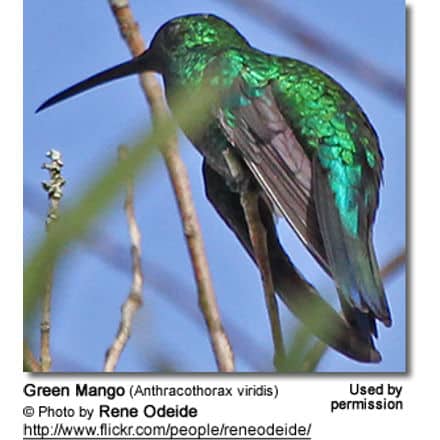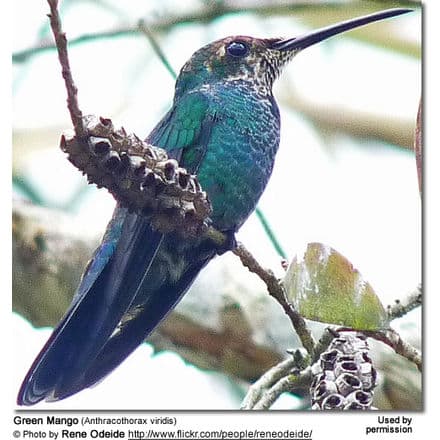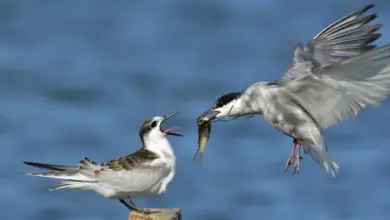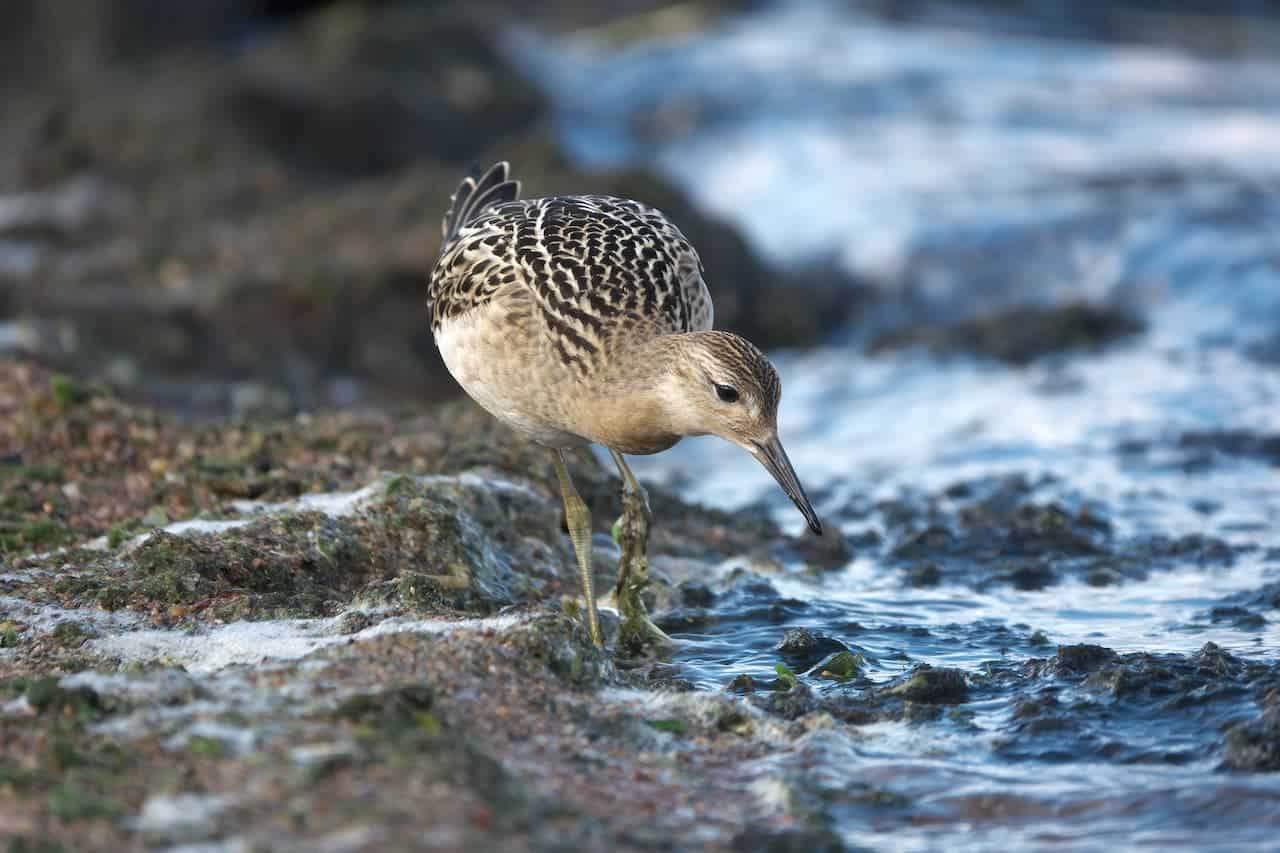Green Mangos
Green Mangos
Hummingbird Information
The Green Mangos or Puerto Rican Mango (Anthracothorax viridis) is a large hummingbird that occurs naturally on the island of Puerto Rico and adjacent islands. This species is often found in forests and along forest edges, on coffee and other kind of plantations in the island’s central and western mountain corridor and its foothills. They are also occasionally found along the southwestern coast.
The Green Mango is one of nine hummingbird species found in Puerto Rico.
Hummingbirds found in: Puerto Rico
Alternate (Global) Names:
Spanish: Colibrí Verde, Mango Portorriqueño / Verde, Zumbador Verde de Puerto Rico; French: Mango vert; Italian: Mango verde; German: Smaragdmango; Czech: Kolibrík smaragdový, kolib?ík smaragdový; Danish: Grøn Mango; Finnish: Viherhohtokolibri; Japanese: midorimangoahachidori; Norwegian: Smaragdmango; Polish: weglik szmaragdowy, w?glik szmaragdowy; Russian: ?????????? ?????; Slovak: jagavicka smaragdová; Swedish: Grön mango
Description
The Green Mango is a fairly large hummingbird measuring 4.5 to 5.5 inches (11 to 14 cm) in length and weighing from 0.23 to 0.25 ounces (6.6 to 7.2 grams). It has a black, down-curved bill. The eyes are dark brown and the feet dusky-colored.
The upper plumage is glossy emerald green, bronze-green or occasional bronze; the plumage below is metallic bluish-green. The wings are a dusky brownish slate, faintly glossed with violet. The dark rounded tail is metallic blue-black or dark steel blue. The under tail feathers are sometimes narrowly whitish-tipped.
Males and females look alike.
Juvenile birds look like adults, but may have darker and duller underparts or have narrow pale grey-brown edging to the feathers of the under plumage.
Similar Species: Resembles the Antillean Mango.
Calls / Vocalizations
The call is an infrequently heard trill-like twitter.
Nesting / Breeding
The Green Mango’s breeding season usually stretches from late winter to early summer.
Hummingbirds in general are solitary and neither live nor migrate in flocks; and there is no pair bond for this species – the male’s only involvement in the reproductive process is the actual mating with the female and, in the case of the Green Mango males, standing guard close to the nest. Males court females by flying in a u-shaped pattern in front of them. He will separate from the female immediately after copulation. One male may mate with several females. In all likelihood, the female will also mate with several males. The males do not participate in choosing the nest location, building the nest or raising the chicks.
The female is responsible for building the cup-shaped nest out of plant fibers woven together and green moss on the outside for camouflage in a protected location in a shrub, bush or tree. She lines the nest with soft plant fibers, animal hair and feather down, and strengthens the structure with spider webbing and other sticky material, giving it an elastic quality to allow it to stretch to double its size as the chicks grow and need more room. The nest is typically found on a low, thin horizontal branch.
The average clutch consists of two white eggs, which she incubates alone, while the male defends his territory and the flowers he feeds on. The young are born blind, immobile and without any down. The female feeds the chicks with regurgitated food (mostly insects since nectar is an insufficient source of protein for the growing chicks). The chicks leave the nest when they are about 20 days old.
Diet / Feeding
Theyprimarily feed on nectar taken from a variety of brightly colored, scented small flowers of trees, herbs, shrubs and epiphytes..They favor flowers with the highest sugar content (often red-colored and tubular-shaped) and seek out, and aggressively protect, those areas containing flowers with high energy nectar. This hummingbird is particularly fond of the Heliconia flowers. They use their long, extendible, straw-like tongues to retrieve the nectar while hovering with their tails cocked upward as they are licking at the nectar up to 13 times per second. Sometimes they may be seen hanging on the flower while feeding. They will sometimes pierce the flower below the stamen to obtain nectar.
Many native and cultivated plants on whose flowers these birds feed heavily rely on them for pollination. The mostly tubular-shaped flowers actually exclude most bees and butterflies from feeding on them and, subsequently, from pollinating the plants.
They may visit local hummingbird feeders for some sugar water, or drink out of bird baths or water fountains where they will either hover and sip water as it runs over the edge; or they will perch on the edge and drink – like all the other birds; however, they only remain still for a short moment.
They also take some small spiders and insects – important sources of protein particularly needed during the breeding season to ensure the proper development of their young. Insects are often caught in flight (hawking); snatched off leaves or branches, or are taken from spider webs. A nesting female can capture up to 2,000 insects a day.
Males establish feeding territories, where they aggressively chase away other males as well as large insects – such as bumblebees and hawk moths – that want to feed in their territory. They use aerial flights and intimidating displays to defend their territories.
Metabolism and Survival and Flight Adaptions – Amazing Facts
Species Research by Sibylle Johnson
Please Note: The articles or images on this page are the sole property of the authors or photographers. Please contact them directly with respect to any copyright or licensing questions. Thank you.








